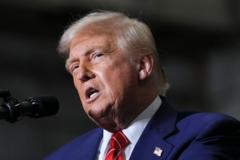In a recent statement, China’s Ministry of Commerce contended that the United States is the party undermining the agreed-upon truce, following President Trump’s claims of China’s non-compliance. The two nations reached a temporary trade truce last month in Geneva, aiming to ease escalating tensions.
China Dismisses Trump’s Claims of Trade Agreement Violations

China Dismisses Trump’s Claims of Trade Agreement Violations
China firmly rebuffs accusations from President Trump, asserting the U.S. has violated their recent trade truce.
China's commerce ministry responded to Trump's social media posts, labeling them "baseless" and accusing the U.S. of implementing “discriminatory restrictive measures” that undermine the agreement. These U.S. actions reportedly include restrictions on critical technology exports to China and proposed visa revocations for Chinese students. The ministry expressed concerns that the U.S. is escalating economic frictions rather than acknowledging its role in the trade disagreement.
Despite the U.S. pushing for tariffs on Chinese imports—which reportedly peaked at 145 percent—each country agreed to reduce tariffs as part of the truce. The U.S. would lower its tariffs to 30 percent, while China would reduce its taxes to 10 percent over a duration of 90 days. However, recent comments from U.S. officials indicate dissatisfaction with China's compliance progress, raising concerns over whether a long-term resolution is achievable before the deadline.
The renewed conflict over the trade agreement raises wider implications for global supply chains, especially as the U.S. emphasizes the need for rare earth metals, critical for various manufacturing sectors.
As tensions heighten, both countries may face pressure to find common ground, emphasizing the precarious nature of international trade relations.
Amy Chang Chien contributed to this report. Daisuke Wakabayashi serves as an Asia business correspondent for The Times, reporting on economic, corporate, and geopolitical issues from the region.
Despite the U.S. pushing for tariffs on Chinese imports—which reportedly peaked at 145 percent—each country agreed to reduce tariffs as part of the truce. The U.S. would lower its tariffs to 30 percent, while China would reduce its taxes to 10 percent over a duration of 90 days. However, recent comments from U.S. officials indicate dissatisfaction with China's compliance progress, raising concerns over whether a long-term resolution is achievable before the deadline.
The renewed conflict over the trade agreement raises wider implications for global supply chains, especially as the U.S. emphasizes the need for rare earth metals, critical for various manufacturing sectors.
As tensions heighten, both countries may face pressure to find common ground, emphasizing the precarious nature of international trade relations.
Amy Chang Chien contributed to this report. Daisuke Wakabayashi serves as an Asia business correspondent for The Times, reporting on economic, corporate, and geopolitical issues from the region.




















